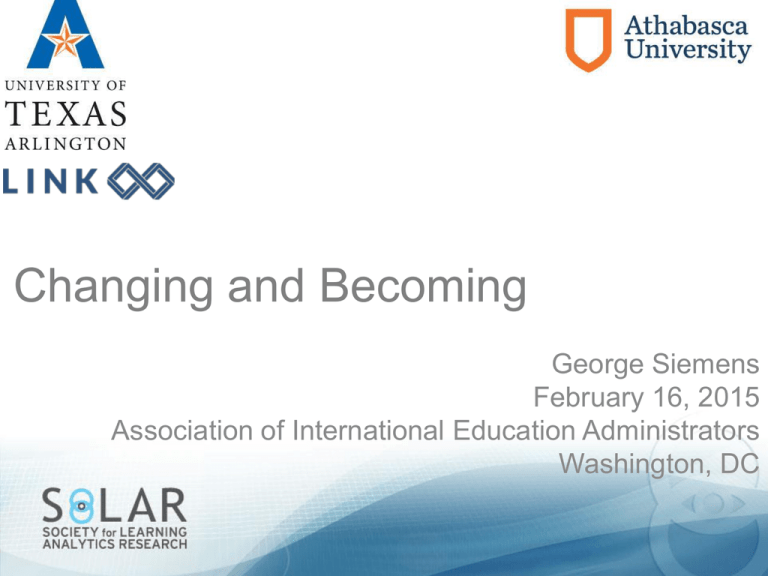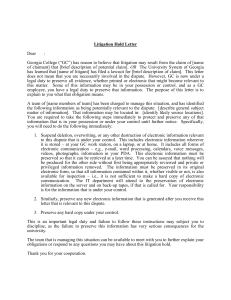Changing and Becoming George Siemens February 16, 2015 Association of International Education Administrators
advertisement

Changing and Becoming George Siemens February 16, 2015 Association of International Education Administrators Washington, DC We are in a chameleonesque era, able to change but not able to become. Jean Baudrillard, 2002 Outline of presentation Changing: Five trends Becoming: Five values to preserve We are presented with a once in (several) generation opportunity to remake and rethink education What we do here will reverberate far into the future Changing Becoming Five Trends 1. Digitization Digital: Connected To understand what tomorrow’s education system will look like, we have to understand the architecture of information today: how is it created how is it shared how is it iterated how is it controlled? Making the world’s knowledge relatable http://linkeddata.org/ Knowledge development, learning, is (should be) concerned with learners understanding relationships, not simply memorizing facts. i.e. naming nodes is “low level” knowledge activity, understanding node connectivity, and implications of changes in network structure, consists of deeper, coherent, learning Knowledge in pieces diSessa, 1993 Digital: Complex What we are seeing is the complexification of higher education Learning needs are complex, ongoing Simple singular narrative won’t suffice going forward The idea of the university is expanding and diversifying Digital: Open Digital: Data “The world is one big data problem” Gilad Elbaz What will LA do for education Add a new research layer Personalization Optimization (move from negative orientation) Organizational insight Improved decision making New models of learning Increase competitiveness Improve marketing/promotion/recruitement “a team at Google couldn’t decide between two blues, so they’re testing 41 shades between each blue to see which one performs better” Douglas Bowman Five Trends 2. Integrated system to ecosystem Control of university: decline of end-to-end integrated system Ed-tech startups With transformations already underway in news, music, videos/movies, startup gold rush now turning focus to education Education Sector Factbook, 2012 Five Trends 3. New learner profiles Enrolment: “perfect storm of challenges ahead” University Business, January 2015 Student profiles Diversifying (OECD) Less than 50% now full time (US Census Bureau) http://www.oecd.org/edu/skills-beyond-school/EDIF%202013-N%C2%B015.pdf http://www.census.gov/prod/2013pubs/acsbr11-14.pdf Favours women over men More learners as % (up to 60%) Average entrance age increasing Top three countries for entering students: China, India, USA Traditional science courses waning in popularity Greater international student OECD 2013 Income inequality: “The defining challenge of our time” Five Trends 4. Alternative credentialing Parallel developing partners: Adaptive and personalized learning Platform Knewton Smart Sparrow Desire2Learn LoudCloud Publisher Pearson McGraw-Hill adaptcourseware CMU OLI Granularization of assessment Cracking the credit hour (New America Foundation) Badges (Mozilla & others) http://newamerica.net/publications/policy/cracking_the_credit_hour http://openbadges.org/ Certificates Fastest growing form of credentialing (800% increase in 30 years) Industry-facing Carnevale, Rose, Hanson 2012 Competencies Competency-based degrees (Chronicle, 2014) Prior learning assessment (Insider Higher Ed, 2012) http://chronicle.com/article/Competency-Based-Degrees-/144769/ http://www.insidehighered.com/news/2012/05/07/prior-learningassessment-catches-quietly Five Trends 5. University relationship to society International/global focus Credit harmonization Learner mobility Global competition International brand development Shifts on learning views Skills gap Life long learning Learning to get a job Personal learning (for the joy of it) Becoming Changing The best time to change is when things are already changing Five Values to Preserve 1. Human factor Student experience At all levels: preparation, entrance, career (Spanier, 2010) Five Values to Preserve 2. Regional economic/work/life impact McKinsey Quarterly, 2012 Local Identity A public place in service of society and the local economy A new model of economic development Building the economy of the future Shaffer & Wright, 2010 Five Values to Preserve 3. Creating a better society Equity of access Under represented learners Quality of learning Opportunities for success Five Values to Preserve 4. Power counterbalance Castells, 2011 Five Values to Preserve 5. Advancing knowledge and research Interdisciplinary “Teaching science as the rational exploration of the unknown, not just mastery of what is known.” The Future It is not a pre-ordained ‘thing’ that will be handed to us It is a network of inter-related factors that will connect/disconnect based on our values and related techno-socio-economic trends Changing Becoming Or Digital Learning Research Network (dLRN) Or PowerPoint slides gsiemens@gmail.com

